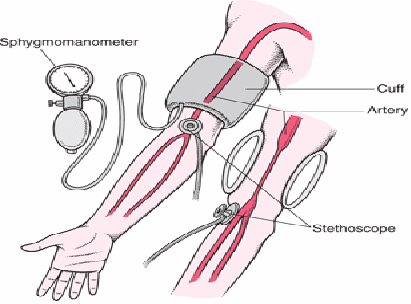Pressure is a basic physical quantity:
![]()
High blood pressure, can warn of impending cardiovascular disease. Low blood pressure can prevent blood from flowing to higher portions of the body, including the brain.
Blood pressure is the force the blood applies to the artery wall divided by the area of the wall. Higher blood pressure means the blood applies more force to each square meter of artery wall.
Blood pressure in measured in millimetres of mercury. A typical blood pressure reading of 120 mm Hg equals 16,000 newtons per square meter or 2.4 pounds per square inch. The blood applies a force of 16,000 newtons to every square meter of artery wall or 2.4 pounds to every square inch.
Diastolic and Systolic Pressure
A blood pressure reading is two numbers, for example 120/80. The higher number and lower numbers are the systolic pressure and diastolic pressure respectively – the highest and lowest pressure of the blood on the artery walls.
With every heartbeat the ventricles (lower heart chambers) contract, squeeze the blood out to the arteries, maximizing the blood pressure, producing the systolic reading. When the ventricles relax, the blood pressure is minimized, producing the diastolic reading. The heart refills with blood and the cycle repeats.
Blood pressure is read with a sphygmomanometer. It uses a blood pressure cuff that squeezes the arm to constrict the blood flow in the artery. The pressure in the cuff is slowly decreased.

Eventually the pressure in the cuff is low enough that blood starts flowing again in the constricted artery. The healthcare worker listening to the artery with a stethoscope hears turbulence as the blood flow resumes, and reads the systolic blood pressure from the sphygmomanometer dial. When the turbulence stops, the pressure reading is the diastolic reading. The blood again flows smoothly because the pressure in the cuff is too low to constrict the blood flow during any part of the pumping cycle.
Blood pressure is taken on the arm at the same level as the heart because the pressure in a fluid varies with the height of the fluid.
Effects of High and Low Blood Pressure
If blood pressure is too high, the extra force on the artery walls eventually leads to increased risk of cardiovascular problems. If arteries are clogged by fatty deposits from high cholesterol, the narrow arteries force the heart to pump harder, leading to high blood pressure. Those with high blood pressure wanting details of the health consequences should consult their physicians.
Pressure in a fluid decreases with height, so there must be enough blood pressure to pump the blood upward to the brain. If the blood pressure is too low the heart cannot push the blood up to the brain and the person may faint.
